Church of MO: 2009 Streetfighters Shootout
Ch-ch-ch-changes, my brethren. 2009 was only one decade ago, but so much has changed. Now the Tuono has four pistons instead of two, Buell has left the building – and so have Duke Danger, Pete, Fonzie, and the antipathy toward naked bikes the lads lamented at the time. Now that it’s 2019, let us embrace our naked ambition, throw off whatever pretensions toward fairness we once thought we had, and prey (upon the weak). Amen.
2009 Streetfighters Shootout: Aprilia Tuono 1000 R, Buell 1125CR, Triumph Speed Triple
Sportbike exotica with a practical side
It seems we may have found one we like a little more than the others, but it wasn’t an easy task! The fact is that all three bikes in our 2009 Streetfighter Shootout are excellent specimens from their makers, each one offering its own unique qualities. With this collection of players, it’s legitimate to apply the cliché that they’re all winners.We think more US riders should be aware of just how great the streetfighter/naked class can be. So we grabbed our buddy Kaming Ko to help us assess a couple of veteran naked bikes, and one semi-new kid on the block We hustled ‘em down the freeway, in and out of cityscapes, and through some of SoCal’s great canyon roads, all in effort to find one that could rise above the other two.
Onward with the flogging!
2009 Aprilia Tuono 1000 R $12,999
View Specs
The Tuono is truly a stripped-down sportbike. Essentially, it’s a naked RSV1000R that’s been retuned to make approximately four less horsepower, but about five more ft-lbs of torque. Seems a good trade-off for a streetfighter. Throw in a motocross-style handlebar, and it’s a ‘fighter fo’ sho’!
Aprilia has been at this naked game for some time now with the Tuono, and it shows in the refined suspension, stable handling and accessible, useable power from its Twin powerplant.
Being a low-volume production machine, the Tuono, like many things Italian, raises the bar in terms of overall quality and fit and finish. Additionally, Aprilia is able to call upon years of successful road racing heritage to inject in its road-going machines.
‘The Tuono is truly a stripped-down sportbike.’
| Engine | |
| • 998cc fuel-injected, liquid-cooled, DOHC, 60-degree V-Twin with an 11.8:1 compression ratio. Claimed output of 139 hp at 9,500 and 79 ft-lbs at 8,500; rear wheel dyno tested at 112.6 hp and 65.5 ft-lbs | |
| • Sports magnesium engine covers. | |
| • Though not the most potent engine here, there’s still considerable stonk down low. The Aprilia will wheelie willingly from second, however, there’s some abruptness from closed to open throttle, primarily at lower rpms, but nothing like the snatchy Buell. | |
| • Clutch engagement doesn’t happen until near full release of the lever. This can make slow-speed maneuvering, like a skillfully executed tight-radius turn, quite difficult. Judging how much throttle to feed in while trying to anticipate when the clutch would hook-up was difficult at times – not a deal breaker, but noteworthy. | |
| • Sticky gearbox; hard to access neutral from a stop. | |
| • Radial clutch master cylinder is a nice addition. | |
| Chassis, handling, etc | |
| • Perimeter sloping twin-spar aluminum frame and aluminum swingarm; 43mm fully adjustable Showa fork and fully adjustable Sachs shock; Brembo radial-mount calipers with twin 320mm floating rotors; Pirelli Diablo Rosso tires. | |
| • Rake, trail, wheelbase: 25 degrees, 4.0-inches, 55.5 inches. | |
| • The combination of linear torque, steering damper and the best out-of-the-box suspension makes the Tuono the most tractable bike here. | |
| • Feels like the slowest steering of the three, but the likely culprit in this sensation is the standard equipment steering damper (something the others lack), 25-degree rake and 4.0- inches of trail. At 55.5 inches the Tuono wheelbase is a full inch longer than the stubby CR’s 54.5 inches, but is 0.7-inch shorter than the Triumph’s wheelbase. | |
| Ergos, looks, etc. | |
| • The Tuono feels physically bigger than the Triumph, and especially so compared to the compact Buell; 31.9-inch seat height; footpegs are a bit high. | |
| • Most robust dash/instruments, but also the most complicated to operate; typical Italian sportbike fare. | |
| • Provides the best wind protection, roomiest ergos and most comfortable saddle; seats on the other two aren’t bad, but the Tuono is best for its wide, flat shape and foam density. | |
| • Overall styling is distinctive, and in many ways best defines the naked/streetfighter theme, as it truly looks like a sportbike that’s been stripped of its bodywork. However, there are a couple odd styling decisions, like the choice to use a specifically styled piece of plastic just to cover a short, innocuous section of small hoses between the right frame spar and bottom edge of the fuel tank. This of course meant that an identical piece of plastic was used on the opposite side of the bike for no other reason than to create visual symmetry. Despite Aprilia going to this extent to cover a couple of barely visible tubes, they managed to leave a large piece of radiator plumping in plain sight. Seems illogical, but again, this is Italian. | |
| • Bungee anchors hidden neatly under the tail section. | |
| • Least exciting exhaust note of the three as heard from afar; for its aggressive styling it should have a more aggressive snort, but it makes a neat pop-pop on the overrun. | |
| • Cool swingarm – about as attractive as a double-sided swinger can be. | |
| • Billet handlebar clamp; eccentric adjustments for toe controls; heavy throttle spring. | |
| • Observed fuel economy: 28 mpg • Claimed dry weight: 408 lbs. | |
2009 Buell 1125CR $11,999
($304 increase from ’08 price)
View specs
Not unlike anything else Buell, the 1125CR is unconventional. An un-faired version of Erik Buell’s first liquid-cooled V-Twin dream, the 1125R, the CR is Erik’s vision of a modern café racer. The large front cowling of the racier R has been eliminated in favor of a single headlight/flyscreen combo.
In order to stick with the café racer theme, the CR comes with low and flat clubman-style bars, just like those rebellious bikes of yore. However, in the company of the other two steed’s upright riding positions, the Buell’s aggressive standard handlebars would’ve detracted severely from its ergos quality.
To remedy this and make things fair we had Buell’s optional upright handlebar installed. The CR is a liquid-cooled extension of the already robust line-up of street warrior Buells.
‘…the CR is Erik’s vision of a modern café racer.’
| Engine | |
| • 1,125cc liquid-cooled, fuel-injected DOHC 72-degree V-Twin with a 12.3:1 compression ratio. Claimed output of 146 hp at 9,800 rpm and 82 ft-lbs at 8,000 rpm; rear wheel dyno test results of 119.4 hp and 65.9 ft-lbs. | |
| • The CR’s torque is matched by the Tuono, as is its horsepower curve, then it leaves the Tuono (and Speed!) behind around 9.5K rpm where it continues to climb to a seven horsepower advantage. Factor in much shorter overall gear ratios, and the CR eats the Speed and Tuono’s lunch as the most potent powerplant in the group. | |
| • Magnesium valve covers; belt final drive is a maintenance coup! | |
| • Can be difficult to ride smoothly at lower rpms through tight twisting roads in either first or second gear due to abrupt throttle and some surging at low rpms/small throttle openings. Shifting to third gear helped smooth the abruptness while metering the throttle during quick transitions between tight turns; short gearing and plenty of power help the CR exit from slower turns in what would normally be one gear too high on the other bikes. | |
| • Similar issue to the Tuono’s clutch engaging near the end of lever travel. | |
| • The CR’s vacuum-assisted clutch, though inventive, isn’t as refined as other slippers on the market. Rapid downshifts on the CR resulted in rear tire chirp and noticeable squirming/sliding. | |
| • Despite Buell claiming no changes in engine tuning compared to the 1125R, our 1125CR proved to be a weaker motor all through the powerband. | |
| Chassis, handling, etc. | |
| • Twin-spar aluminum fuel-in-frame and aluminum swingarm; 47mm USD fully adjustable Showa fork and fully adjustable Showa shock; ZTL-2-type brake, eight-piston fixed caliper, 375 mm single-sided inside-out floating rotor; Pirelli Diablo Corsa III tires. | |
| • Rake, trail, wheelbase: 21.0 degrees, 3.3 inches, 54.5 inches. | |
| • With the most powerful engine, tightest ergos, shortest wheelbase and aggressive geometry, the 1125CR is what Pete imagined riding a 120-hp pocket bike might feel like. | |
| • “Seat-of-the-pants feedback provided very nervous feeling compared to the Triumph Street Triple and Tuono,” exclaimed Kaming. | |
| • Adjusted shock preload to its second-softest setting but it was still firm. | |
| • Pete has said before that the 1125R could use a steering damper; this is even more the case on the CR as echoed by Kaming. “It is the only bike I am afraid to push hard in and out of corners. Just never sure what it is going to do.” The Buell is always on the verge of, if not actually, shaking its head when powering out of a corner, or from aggressive stop-light departures. The bike has a rowdy pitbull character to it: a little untamed, but can be very fun under the right conditions! | |
| • Ultimately the Buell’s unique ZTL-2 brake has enough stopping power, but initial bite is too soft, leading to more lever squeezing than what might be anticipated. In light of the Brembo-equipped competition it doesn’t perform as well. | |
| Ergos, looks, etc. | |
| • The 1125CR seems like it offers more clackity mechanical noise than it does intake or exhaust music. | |
| • Lowest seat height at 30.5 inches adds to the friendly but compact ergos. | |
| • Fore and aft adjustment of the brake pedal and shifter peg is a useful addition; highest footpegs; would be a nice touch if peg height was also adjustable. | |
| • Limited wind protection, but much better than the fully-nude Speed Triple. | |
| • With the on-board CruzTools tool kit, there’s virtually no roadside adjustment, including tuning either the fork or shock, that can’t be made. | |
| • Unusual styling creates a love it or hate it division among most riders. At a minimum, there’s nothing like it today on the road! | |
| • Cooling fan loud and almost always on, even with ambient temps in the mid-50s. | |
| • Observed fuel economy: 28 mpg • Claimed dry weight: 375 lbs. | |
2009 Triumph Speed Triple $11,299
View Specs
A good way to describe the Speed Triple would be minimalistic but not necessarily simplistic. The pared-down quality comes from years of experience as the iconic mass-produced streetfighter. With the Triumph you get heritage, as Triumph wisely capitalized on the ingenuity of what English backyard bike nutz were doing years ago with early GSX-R, Ninja and similar sportbikes.
Stripped of damaged bodywork, these motorcycles that were otherwise mechanically sound were saved from the clutches of total ruin. Made into a wicked combo of a practical and comfortable ride with the power and handling of a sportbike, the streetfighter was born.
Triumph knew a good thing when they saw it, and from its early lineage, the Speed Triple gave the people what they wanted: a powerful, torquey mill with everyday livable ergos.
‘A good way to describe the Speed Triple would be minimalistic but not necessarily simplistic.’
| Engine | |
| • 1,050cc fuel-injected, liquid-cooled, DOHC in-line Triple with 12.0:1 compression ratio. Claimed output measured at crank is 130 hp at 9,200 rpm and 77 ft-lbs at 7,500 rpm; measured rear wheel of 114.4 hp and 69.2 ft-lbs. | |
| • Overall gear ratios are nearly identical to the Tuono, but with over a four ft-lb advantage in torque, the Speed takes the upper hand in lower rpm response. | |
| • The three-cylinder Triumph out-pulls the V-Twins in this group until it hits its rev limiter. On the AreaP dyno, it registered a 9,500-rpm limit rather than the 10.5K as shown on the tachometer. | |
| • Strange that a multi-cylinder mill has a shorter rev ceiling than the V-Twins; chalk it up to an engine with a long stroke that nearly matches its bore (79×71.4mm). | |
| • Smoothest feeling mill with limited buzz and mechanical noise. | |
| • The Speed’s clutch and transmission are a refined package with the cable-actuated clutch offering the best feel. | |
| Chassis, handling, etc. | |
| • Tubular aluminum perimeter frame and single-sided aluminum swingarm; 43mm fully adjustable USD Showa fork and fully adjustable Showa shock; Brembo radial-mount calipers with 320mm rotors; Dunlop Qualifier tires. | |
| • Rake, trail, wheelbase: 23.5 degrees, 3.3 inches, 56.2 inches. | |
| • It’s more stable than Buell, but not as stable as the Tuono and only slightly quicker steering. | |
| • Best brakes of the bunch. The radial-mount Brembos on the Speed provide a very direct feel; has a radial master cylinder as does the Tuono. | |
| • Suspension isn’t as well-sorted as the Tuono; it’s a bit softer but offers a slightly harsh ride over high-speed bumps. | |
| Ergos, looks, etc. | |
| • The twin spotty headlights, simple but effective instrument cluster, single-sided swinger, high and tight twin undertail exhaust, and tubular perimeter frame make the bike immediately recognizable as a streetfighter, and English! | |
| • The combination of intake snort and exhaust snarl inherent in this Triple is unmatched by the other two machines. The Tuono and 1125CR don’t quite make the direct visceral and aural connection that the Speed makes with its rider. | |
| • Though the rider triangle is quite neutral, the Speed’s tallest seat height at 32.1 inches is noticeable. | |
| • One of the first things to do after buying a Speed Triple would be to get the accessory fly screen. Wind protection around town isn’t much of an issue, but at 80+ mph on the freeway the lack of wind protection means holding on tight to prevent being blown off the seat. | |
| • One-piece seat is removed easily via key release granting quick access to the battery. | |
| • Lowest footpegs. | |
| • Observed fuel economy: 33 mpg. | |
| • Claimed dry weight: 416 lbs. | |
Summary
Many of the same wacky traits that we like about the Buell are also many of the reasons we wouldn’t place it as choice numero uno. Riding a bike that’s somewhat unruly by nature can provide lots of giggles, but only if you like that sort of thing all the time. If that’s your cup of coffee, then the 1125CR is your ticket to good times all ‘round.
However, being ever-conscious of judicious throttle use could eventually suck some of the fun out of riding this bike everyday. After all, who wants to lean on the faux fuel tank every time you decide to crank on the throttle when leaving the gas station or grocery store parking lot? Maybe you do.
Also, the CR’s brakes aren’t quite up to par as the other two bikes. The aggressive steering geometry and abrupt throttle response make the 1125CR a bike you often need to be one step ahead of when riding at a spirited pace. This all translates into mental energy, and doesn’t leave as much room for casual enjoyment. It’s a bike best suited for the experienced sport rider.
We really like the way “Mr. Experience” Kaming, summarizes the Buell: “It’s like the first time looking at a red lobster, uncertain what this creature tastes like by its unusual look until you try it. Then you wanted more. If Buell’s intention was to create a bike for canyon roads, they mastered it. But, being around Italian bikes for the past 33 years, it will take some time for me to get use to their lobster styling.”
The Aprilia and Triumph are in a neck-and-neck race. The Tuono offers a stable, predictable ride with plenty of classic V-Twin power traits. Captain Duke said it’s the easiest to ride, and inspires confidence immediately, as there’s “no acclimatization necessary.”
The Speed Triple on the other hand is, well, a Triple! What does that mean to the uninitiated? Plenty of smooth, linear power from the get-go, not to mention an intake and exhaust note found on no other bike. The Triumph handles nearly as well as the Tuono, has equally as good brakes, acts the hooligan like a true streetfighter, and does it all for $1,700 less than the Tuono. And that could get you plenty of fuel or you keep you in good supply of rubber. Still, the Aprilia just seems a notch above in terms of overall quality. “It’s the Honda-est,” Duke says of the Tuono.
When we sat down to hammer out which bike came out on top, it was impossible to ignore the many compelling attributes of the Tuono. It does nearly everything at the top of its class, providing a versatile platform for almost every riding environment. And a rider will feel proud gazing at all the gorgeous components that add up – It looks like it costs the most because it does cost the most.
But not too far behind is the appealing Speed Triple, still an intoxicating machine despite its age. A trackday rider will go quicker on a Tuono, but a street rider will appreciate the Triumph’s best bang for the buck in a Euro streetfighter.
Related Reading
2008 Triumph Speed Triple 1050 Review
2008 Triumph Urban Sports Review
Three Naked Euros
2004 Streetfighter Shootout
Open-Class Standards 2006
2008 Naked Middleweight Comparison: Triumph Street Triple 675 vs. Aprilia SL750 Shiver
2009 Buell 1125CR Review
More by John Burns



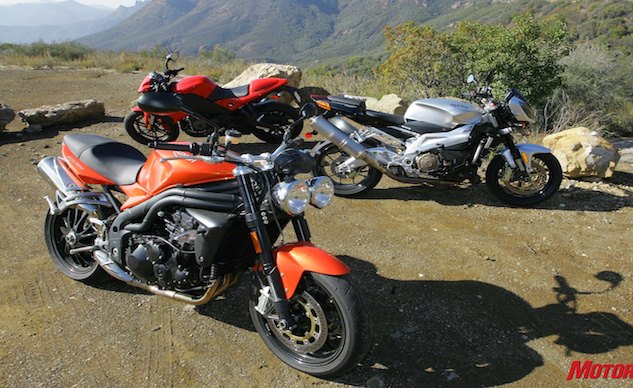














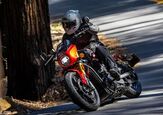
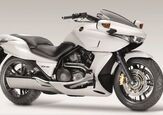
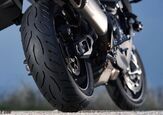

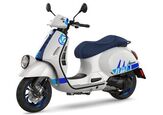

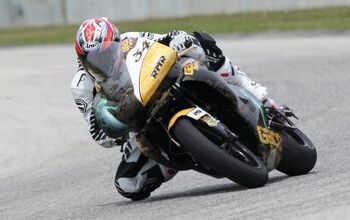
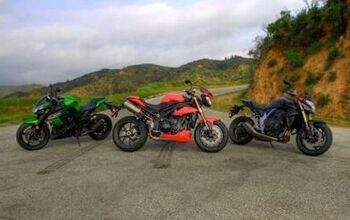
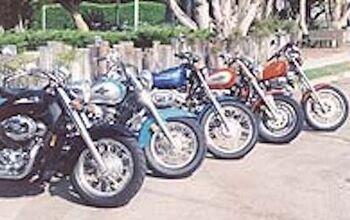
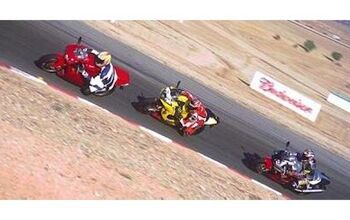

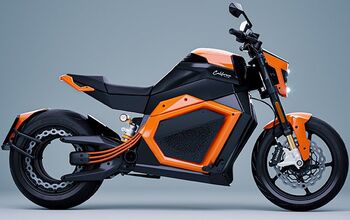
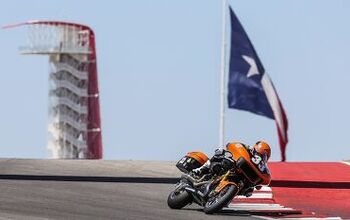
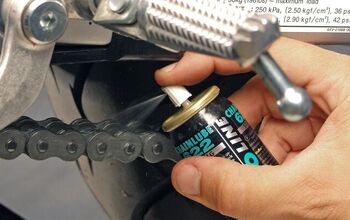
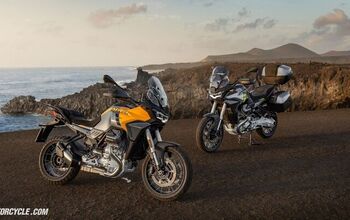
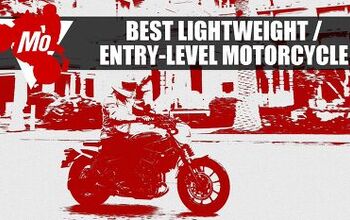
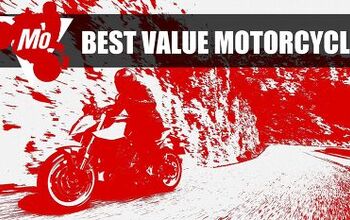


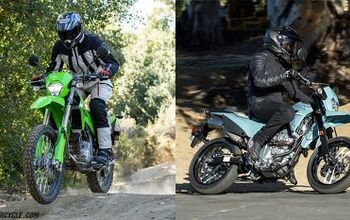
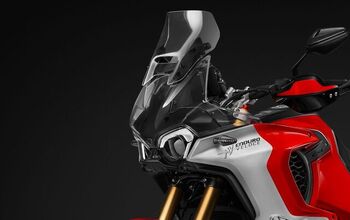
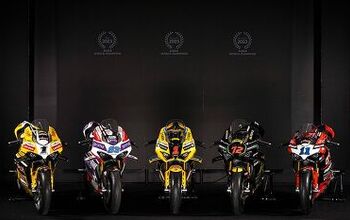
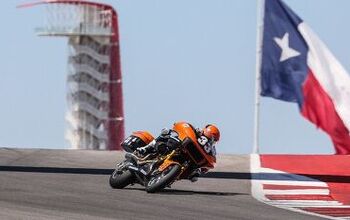
Comments
Join the conversation
In 2010 I was looking at street fighters, but in the mid size. I ended up with a Shiver, a year later it was gone and bought the Street Triple R. Triumph back then and still today, build great street fighter/naked bikes. Today I own a newer Street Triple R and a Brutale RR. Sporty with all day comfort.
I loved that iteration of the Speed Triple. Triumph would do well to go back to the symmetrical bugeye headlights, rather than whatever those Cylon things are. No, wait--"Bugeye" would be an Austin Healey thing. Whatever. I may very well pick up a new Speed Triple along the way, but I'd have to factor in the cost of converting to round headlights. My kids might be able to live with the monstrosity of the new face, but not me. I've gotta drool when I look back at it over my shoulder. The difference between the old round headlights and the new polygonal ones is the difference between drool and spit.
The Buell was cool and had great appeal, but of these, I'd gravitate to the Triumph every...single...time. Nothing against Aprilia--there's a big Aprilia scooter in my garage that is a hoot. My three Weimaraners will chase it for miles in the middle of the night. Well, they used to, until they determined it was no more interesting than chasing sticks. Sticks? WTH?